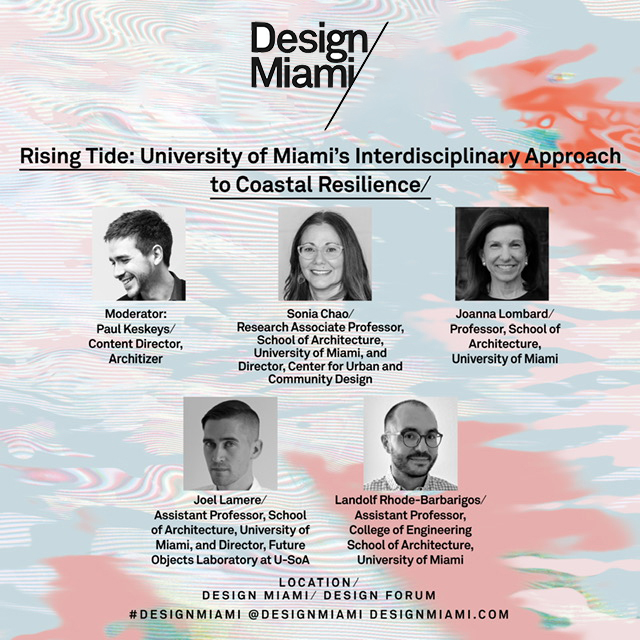U-SoA and CoE faculty participated in Rising Tide: University of Miami’s Interdisciplinary approach to Coastal Resilience at Design Forum at DesignMiami on Sunday, 12.08. The panel discussion was led by Sonia Chao, Research Associate Professor (U-SoA, CoE), Joel Lamere, Assistant Professor (U-SoA), Joanna Lombard, Professor (U-SoA), and Landolf Rhode-Barbarigos, Assistant Professor (CoE, U-SoA), team members of UM’s U-LINK initiative, a program that promotes interdisciplinary research for practical applications and problem-solving. The panel, focused on sea-level rise and related challenges in translating scientific research into design innovation. UM’s U-Link projects include innovative solutions for the next generation of coastal design and proposals for minimizing wave energy through the restoration of green infrastructure.
Professors Landolf Rhode-Barbarigos (CoE, U-SoA) and Sonia Chao (U-SoA, CoE) began the panel discussion by describing their various funded research and outreach collaborations, including a National Science Foundation grant to create a human-centered modeling of coastal resilience. They described their current U-Link joint investigations and the structure of their entire team. Rhode-Barbarigos is collaborating with peers at RSMAS to design and analyze enhanced coral reef beds off of Miami Beach to understand their performance and how to improve upon their designs. Chao and her sub-research team have developed a modeling system to quantify how the urban and building fabric of any given location will be impacted by a hurricane’s accompanying storm surge wave action. She and Benjamin Ghansah, a geo-spatial specialist have dubbed their method/model the “Storm Surge Building Vulnerability” (SSBV) assessment. The final drawings have been produced by CUCD research assistants, Alba Quintanilla, Alexandra Dreybus, and Jazzmin Reid. In the end, Chao and her team, will quantify to what degree an enhanced coral reef can better protect the urban realm from the power of wave actions and flooding, thereby providing local decision makers with the facts they would need to determine if it is a good public investment strategy. Because the model also identifies vulnerabilities at the scale of buildings, the results can also serve to provide property owners with additional information, which can aid in directing their incremental resiliency investments. This modeling accounts for wave action, sea level rise, socio/economic and built/urban factors at any given localized area.
The panel moderator, for the discussion, was Paul Keskeys, Content Director, Architizer.

